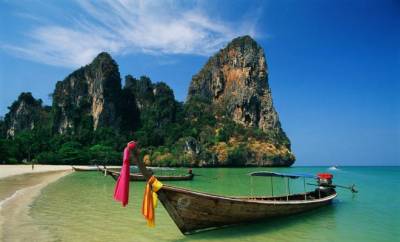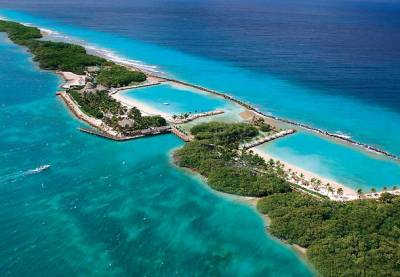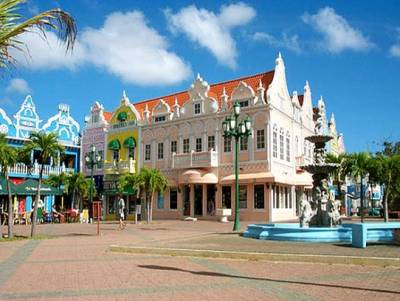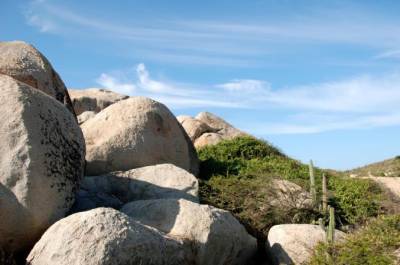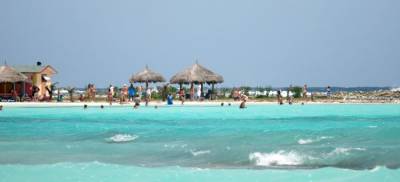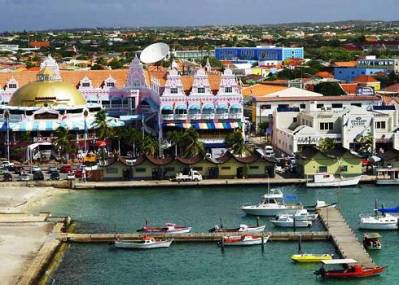ARUBA
GENERAL INFORMATION
Aruba - one of the most beautiful islands in the Caribbean and one of the most prestigious resorts in the world. No wonder his name is associated with the Spanish "Oro Ruba" ("red gold"). Lifestyle, customs and language, a bustling nightlife, beautiful urban architecture and numerous windmills - all bear the stamp of the Dutch culture. Excellent facilities for golf, tennis and active sports in the first place - water, allow to combine a stay here with sports. In the evening, the lights luxurious casinos, discos and nightclubs with original entertainment. While here even climate, gently sloping shore, surrounded by sand dunes from the shore and rocky massifs, and from the sea - reefs and shoals, friendly local people and unique culture, which allows for time with health and soul.
Geography: A small island in the heart of the Caribbean Sea about 30 km in length and a width of about 10 km. The coast is characterized by sand dunes and rocky cliffs.
CLIMATE
Climate: temperate rain. Change of seasons is almost invisible. A large number of sunny days and cool sea breeze create an optimal temperature for rest - about +29 ° C. From November to December in Aruba during the rainy season, they are short-term in duration.
LANGUAGE
The official language - Dutch. Almost all residents are fluent in English and Spanish. In addition, the islanders use something called Papiamento, which is a mixture of Dutch, Spanish, Portuguese, English and local Indian dialect.
HOLIDAYS
Holidays and public holidays: New Year, January 25, Friday - Carnival, Good Friday, Easter Monday, March 18, April 30 - the birthday of the Queen, 1 May, Ascension Day, 25 and 26 December.
CURRENCY
Currency: Aruba Florin (AFL), made up of 100 cents. Payment is also accepted U.S. dollars and all major credit cards, travelers' checks.
VISA
Visa: required. Put in the Embassy of the Netherlands term visa - 7 days and 2 days put a transit visa Netherlands (if you fly via Amsterdam).
CUSTOMS
Border and customs control: in addition to the things for personal use, free of duty can be made of 200 cigarettes or 50 cigars or 250 grams of tobacco and a limited amount of alcoholic beverages.
SHOPS
Aruba is a zone of free trade. In shopping centers, boutiques can be found almost all well-known companies in Europe and America. Prices are much lower than in Europe. Especially a lot of very high quality and cheap Colombian emeralds, topaz and diamonds.
SAFETY
Aruba virtually crime.
Health standards for the quality of food and water strictly followed. Almost every hotel has its "doctor on call." It is recommended to be vaccinated against hepatitis A and polio
WHAT TO SEE
Oranjestad
Bright and fresh, as if painted in pastel color, the capital of Aruba is located on the south coast, the south-east of the main resort area of the country. Picturesque town has a distinctly pronounced Dutch influence, marked here and in the buildings of colonial architecture with typical gabled roofs, and in the old mill, imported directly from Holland (today the restaurant), and in the many tiny cafes and bars, which are often seen simply as a hole in wall. Most tourists come to the capital for shopping, the benefit of the many duty-free shops can make it absolutely smoothly. But much more attention should be given all the same local historic attractions, of which, unfortunately, is usually overlooked.
In Oranjestad have 4 small but interesting museum. Archaeological Museum is worthy exhibitions on the history Arawakan culture. Museum-Arubano (Historical Museum), located in the restored fort Zutman (XVIII c.), Contains an extensive collection of pre-Columbian history on the island and the colonial era. A unique Numismatic Museum is known for its extensive collection of coins from 400 countries, some of which was found at the bottom of the sea in the sunken ships conquest era. There is also a small geological museum with extensive collection of exhibits on the history of the origin of the island of Aruba and the Cultural Centre with a large variety of exhibits.
In such a small town, as it turns out, there are many churches. Of particular interest to tourists are the Catholic Church of St. Anne in Nord (just north of the capital) with a unique hand-made oak altar (in 1870, the church itself was built in the period from 1914 to 1919.) Rectory at the church of St. Anne ( 1877, is the oldest structure of its kind on the island), the Church of St. Francisco, Bahai Temple, Faith, Temple Beth-Israel, Bible Baptist Church path to Hyuygenshtrat Evangelical Church, the Methodist Church (1846) on Longfelloshtrat, the New Apostolic Church on Geletshtrat, the Protestant church on Vilgelminashtrat and others. Modest domes and steeples of local churches is particularly impressive look at the background of the colorful mountains Hamanota that height is more like a hill, but very effectively sets off the colorful neighborhoods of Oranjestad.
The picturesque chapel Alta Vista or "Chapel", the first Christian cult building in Aruba, located on the northern coast of the island. The first church on this site was built in 1750 by the joint work of the Indians and the Spaniards, and has long been the center of Catholicism in Aruba. After years of neglect the chapel was restored in 1952, and today is a national shrine, in which, however, regular worship. Entrance to the picturesque yellow chapel is open to visitors every day, and two graves at its walls, which are supposedly the burial place of the founders of the church, and Domingo Antonio Silvestre Miguel Enrique Albaresa, became one of the pilgrimage sites of local residents.
Natural Bridge
Unique landscape monument of the country - Natural Bridge, was formed by centuries of exposure surf rocky northern coast of the island. Today this tridtsatimetrovaya stone arch height of 7 meters towers over the cliffs near the beautiful beach Andikuri, forming one of the most favorite places of Arubans. Nearby, on the leeward coast, there is another natural wonder - surrounded nowhere Grasp here stone boulders natural pond "finish" or Cura de Tortuga with sea water.
National Park Arikok
Even at the map shows that Aruba - a tiny island. Nevertheless, here, on this piece of land, almost 20% of the territory placed under the protected area. Real decoration of the island - National Park Arikok takes huge by local standards, a site on the northern, windward coast, and around the mountains Arikok Hamanota. In the park you can find a huge range of natural and historical attractions - Arawakan petroglyphs in a cave Fontaine, Dutch colonial settlement in Masiduri, the building is an old plantation in Prince Valley and the ruins of the gold mines in Miralamar. On the slopes and Hamanoty Arikoka runs a network of beautiful hiking trails, go right through the trees of unusual plants, like trees "kvihi" and "divi-divi", and beautiful landscapes. The park is perhaps the most diverse preserved animal communities on the island.
Gvadirikiri caves and "Tunnel of Love" hidden on the outskirts of the park Arikok. The cave complex is famous Gvadirikiri two underground rooms where through holes punched in the top of the sun's rays, creating a totally surreal play of light and shadow. Stretching more than 30 meters, winding tunnels are home to thousands of bats are harmless and, as legend has it, was once a pirate secret bases. Cave Huliba also known as the "Tunnel of Love" received its name because of the input tunnel, indeed resembles a section of a stylized silhouette of the heart.
California Lighthouse
The area around the old California lighthouse, named after the ship "California", which sank of the coast, is an isolated north-western region of the island. The area offers the most spectacular scenery on the island, formed by sand dunes, magnificent beaches and scrub. Business card area - old stone California Lighthouse (XVIII c.) Near Tierra del Sol, one of the most beautiful buildings on the island. Isolated northwestern part of the island known as Hudishibana and is another picturesque area of the island is almost entirely occupied by the large dunes and framed by rocky cliffs with small coral reefs.
Ayo Rock
Unique area of cliffs and canyons Ayo Rock - one of the most mysterious areas of Aruba. For such a flat, sandy islands that are Aruba, the presence of rocks (especially quartzite and diorite) and huge monolithic boulders that literally covered this area, is an elusive challenge. Among the stone formations in the Ayo Rock once lived a mysterious ancient race, leaving behind an amazing petroglyphs on stone boulders. And the region is literally full of huge stones, as if specially folded in concentric circles. Scientists still can not explain how these rocks are here, and who laid the giant ring - people or nature.
North Hoiberga ("haystack" so Arubans call themselves rock formations) over the desert region rises another rock puzzle. Some of the boulders weighing several tons and have an odd shape. Government of Aruba is based here recreational area, paving between huge boulders, hiking trails leading to the summit of a rocky hill (165 m), which offers a breathtaking view of the island. The parched scrub and cactus around Kasibari frame diorite giant boulders that winds and erosion have turned into strange stone sculptures.
San Nicolas
The second largest city in Aruba, San Nicolas - quite modern town that is different from other settlements of the island is clearly visible British influence. For many years one of the main reasons to visit the town is Charlie Bar. This bar has become famous from the 40's of the XX century, when the host institution began posting on the walls of the various finds from the seabed. Since then, the bar has a small museum, which attracts thousands of tourists to the city from around the world. Also noteworthy to Christ Church, the Evangelical Church of St. Nicholas, the Anglican Church of the Holy Cross, Holy Teresita, Seventh-day Adventist Church in the Doctor-Shepmanstrat and many picturesque old houses. North-east of San Nicolas, on the hill gray-Preto, is another relic of the island - carved in stone grotto of Lourdes Catholic chapel (1958). The chapel was founded in honor of the appearance of the Virgin local woman in 1808. Every year on February 11 procession in honor of Lady of Lourdes follows from St. Teresita to the grotto, where he held a solemn mass.
Coast and beaches
However, the main attraction of Aruba - its banks. Beautiful beaches, clear water, lots of small coral reefs and good infrastructure are attracting thousands of visitors. The best beaches are considered to Arashi Beach and Hadikurari Beach near the California Lighthouse on the north-western end (considered the best place for snorkeling on the island), the purest Druif Beach Bukuti Beach (considered one of the best beaches the Caribbean and the world), which lie directly front area of luxury hotels beaches of Palm Beach and Eagle Beach, quieter Roger Beach and Baby Beach in Gray of Colorado to the south-east of the island, a small isolated island Renaissance, lying directly opposite the harbor of Oranjestad, and the island is surrounded by coral reefs De Palm. Aruba has more than 40 sites with good conditions for diving and snorkeling (in some places visibility in the water up to 30 meters), and the rich marine life for a long time is in all guide books as a separate attraction of Aruba. In addition to excellent conditions for scuba diving, many exotic beaches offer this service as a submarine dive, specially designed for this purpose. Persistent strong winds, along with a variety of water conditions, especially the waves make Aruba one of the most popular places in the world for windsurfing and kitesurfing.
Many choose Aruba as a resting place for the love of gambling. And no wonder - Aruba has several first-class casino - Hyatt, Renaissance Crystal Renaissance Sipot, Excelsior-line, etc. Some of them are open around the clock (schedule depends on the season). Large casinos are not inferior to the luxury and abundance of game entertainment complexes in other countries. By the way, the entrance to persons aged under 18 years in many of them is forbidden.
